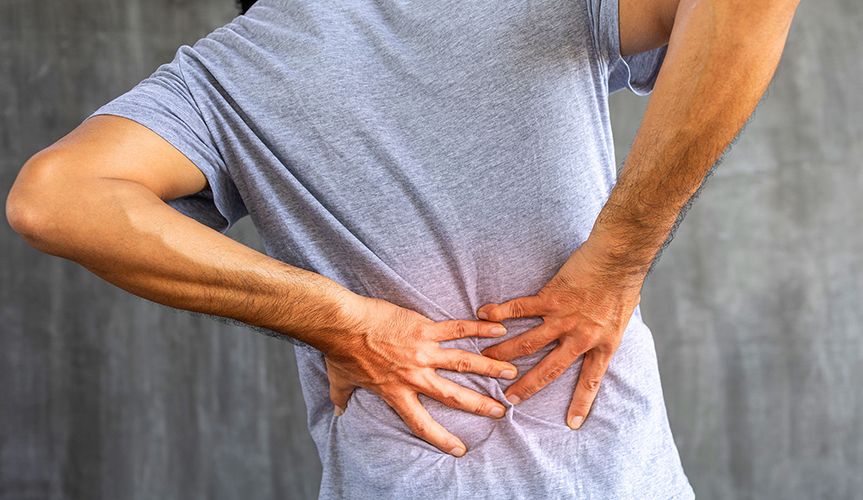
Low Back Pain

What Is Low Back Pain?
Low back pain refers to discomfort, stiffness, or soreness in the lumbar region, which includes the five vertebrae at the base of the spine. This common condition affects people of all ages and can range from mild, temporary aches to chronic, debilitating pain. Low back pain often impacts daily activities like standing, bending, or lifting.
What Causes Low Back Pain?
Low back pain can arise from various factors, including:
- Injuries:
- Muscle or ligament strains: Often caused by heavy lifting or sudden awkward movements.
- Herniated discs: When the soft tissue between spinal vertebrae bulges out, compressing nearby nerves.
- Fractures: Resulting from trauma or osteoporosis.
- Degenerative Conditions:
- Osteoarthritis: Wear-and-tear damage to the joints in the spine.
- Degenerative disc disease: Age-related changes in spinal discs leading to pain and stiffness.
- Spondylolisthesis: A vertebra slips out of place, pressing on nerves.
- Nerve-Related Pain:
- Sciatica: Compression of the sciatic nerve causing pain radiating down the leg.
- Spinal stenosis: Narrowing of the spinal canal that puts pressure on nerves.
- Lifestyle Factors:
- Poor posture during sitting, standing, or sleeping.
- Sedentary lifestyle or weak core muscles.
- Other Causes:
- Infections or tumors in the spine.
- Kidney stones or urinary tract infections that refer pain to the lower back.
- Fibromyalgia or other chronic pain conditions.
What Are the Symptoms of Low Back Pain?
Low back pain can present with various symptoms, depending on its cause:
- Persistent aching or stiffness in the lower back.
- Sharp or shooting pain that may radiate to the buttocks or legs.
- Difficulty standing, walking, or bending due to discomfort.
- Numbness, tingling, or weakness in the legs, often associated with nerve compression.
- Muscle spasms or tightness in the low back.
If low back pain is accompanied by symptoms like fever, sudden weight loss, or loss of bowel/bladder control, it requires immediate medical attention.
How Is Low Back Pain Diagnosed?
Diagnosing lower back pain involves a combination of clinical evaluation and diagnostic tools:
- Medical history: Your healthcare provider will ask about your symptoms, lifestyle, and any previous injuries or conditions.
- Physical examination: They’ll assess posture, range of motion, and areas of tenderness.
- Imaging tests:
- X-rays to detect fractures or arthritis.
- MRIs or CT scans to evaluate soft tissues, such as discs and nerves.
- Other tests:
- Blood tests to rule out infections or inflammatory conditions.
- Nerve studies to assess potential nerve damage.
What Are the Treatment Options for Low Back Pain?
Treatment for low back pain depends on its cause and severity. Common approaches include:
- Conservative Treatments:
- Resting briefly to reduce strain, but avoiding prolonged inactivity.
- Applying ice or heat packs to relieve pain and reduce inflammation.
- Taking over-the-counter pain relievers, such as ibuprofen or acetaminophen.
- Physical Therapy:
- Strengthening and stretching exercises to improve core stability and spinal support.
- Techniques like manual therapy or traction to relieve pain and restore mobility.
- Injections:
- Corticosteroid or biologic injections to reduce inflammation around nerves or joints.
- Nerve blocks for targeted pain relief.
- The Discseel® Procedure (link to → https://regenespine.com/discseel-minimally-invasive-low-back-neck-thoracic-regenerative-pain-treatment-nj-ny/)
- Alternative Therapies:
- Chiropractic care, acupuncture, or massage therapy for symptom relief.
- Surgical Options:
- For severe cases, procedures like discectomy, spinal fusion, or laminectomy may be considered.
- Lifestyle Modifications:
- Maintaining a healthy weight to reduce strain on the lower back.
- Practicing good posture and ergonomic adjustments at work or home.
When Should You See a Doctor for Low Back Pain?
You should consult a healthcare provider if:
- The pain persists for more than a few weeks or worsens over time.
- Pain radiates down the legs or causes numbness, tingling, or weakness.
- There are signs of infection, such as fever or redness near the spine.
- You experience difficulty controlling your bladder or bowels.
Reclaim Comfort and Mobility Today
Low back pain can limit your daily activities, but effective treatments are available to help you regain comfort and functionality. If you’re experiencing persistent or severe symptoms, consult a healthcare provider for a thorough evaluation and personalized care plan. Don’t let low back pain hold you back—take the first step toward relief and a healthier back today!
